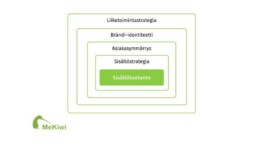How do I create meaningful content?
Content is always produced for the customer. It needs to reach the right customers and address them in the right way. Business strategy, brand and customer understanding are the cornerstones of content production. They give the content a strategic direction, a way of working and communicating, and create value for the customer. The key to meaningful content production are buyer personas, the purchase paths created for them, timely content and content linking from different channels to websites.
How do I strategically produce the right content?
Content marketing is part of a company’s marketing strategy. In the same way as the marketing strategy and the marketing plan that implements it, the content strategy and content production also follow the business strategy of the company. In this way, the organisation works in harmony towards the goals set.
Strategically, we know, for example, to whom, what, how and where we market and sell. From the perspective of a content strategy, it is meaningful to know what kind of buyer personas we want to reach, engage and serve, and how we manage content in different channels and websites. When content is created around the problems and goals of the buyer persona, sales grow, the brand is strengthened, and our company succeeds.
For the overall brand of the company, it is important that the communication is in line with the brand. The communication of brand identity and value proposition is reflected in all communication, so it should not be forgotten in content production either. The contents consistently reflect the company’s personality, way of working and communicating. Brand should manifest itself in all forms of communication, both visual and spoken content. Consistency of communication increases the credibility of the company in the eyes of the client.

How do I add customer focus to content production?
The better we understand the customer, the easier it is for us to produce content. Customer research provides valuable information for defining buyer personas and the factors that guide a purchase decision. The goal of customer orientation is to create value for the customer with every channel and content. Well-executed content is interesting, informative and motivating for the customer and supports the purchasing process. They also improve the interaction and cooperation between the customer and the company.
The content creator is particularly interested in the customers’ purchasing and service experiences. Purchasing services requires expertise and is often challenging for the customer. Customer satisfaction and efficient and profitable sales are best realised when the customer’s purchase path and the company’s sales path go hand in hand. The client is provided with useful content in a timely manner at different stages of the purchase path.
Customers can be provided with more relevant content that facilitates and speeds up the buying process. For example, a website can create a unique purchase path for each buyer persona. At the beginning of the customer’s purchase path, the task of content production is to support the findability of the website and the intelligibility of the content of the service descriptions. Content linking and search engine optimised content help the customer find the company’s services. The content of the website should provide information and support the customer in the purchase process. Meaningful content entices the customer to progress from one content to another and leads the customer towards a purchase decision.
Is your content creation relevant? At MeKiwi, we use service design to study customer experience and develop the digital purchase path. As digital marketing experts, we can help your company develop content production. We look at your company’s goals and needs. We create an overall picture of the development project for you, what we do, how we proceed and what we achieve together.
Tips for remote conferences
In the current global situation, remote conferences and fairs have begun to grow in popularity, bringing new challenges to company’s sales representatives.
Connection problems and staring at the screen can seem numbing and people can easily distract themselves with news or by browsing social media, reducing effective participation. We decided to share with you a few tricks that our VR Account Manager Aatu Numminen collected to make the most out of this new way of networking.

Focus on your goals - Just like at a traditional fair, the most important thing for a productive day is clear goals. Looking for leads or to find new perspectives? Plan your day accordingly! If you’re working with your colleagues, sharing tasks will help a lot.
Lead Hunting - Most remote conferences use chats as part of presentations, giving companies the opportunity to discuss the topic. “It’s easy to move such conversations to LinkedIn, for example, and making networking happen naturally.”

Multiverse - Remote fairs can let you participate to multiple talks at the same time on the speakers’ “ virtual stages ”. This lets you network with more people in one day. The most important thing is to find the limit of your own focus so you can keep up with all the conversations.
Endurance - During a computer-based conference there's a risk of forgetting to eat or take breaks. Focusing intensely on a screen can also start to feel heavy. "Personally, I have solved the problem by increasing the volume of the conversations, so I can easily follow them even during a break."



